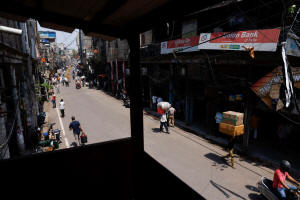India re-opens major cities as new COVID-19 infections hit 2-mth low
 Send a link to a friend
Send a link to a friend
[June 07, 2021]
By Neha Arora and Shilpa Jamkhandikar
NEW DELHI (Reuters) -Key Indian cities
re-opened for business on Monday, with long queues for buses in the
financial hub of Mumbai while traffic returned to the roads of New Delhi
after a devastating second wave of coronavirus that killed hundreds of
thousands.
The 100,636 new infections of the past 24 hours were the lowest in the
world's second most populous nation since April 6, and well off last
month's peaks of more than 400,000, allowing authorities to re-open
parts of the economy.
"We have to save ourselves from infection but also bring the economy
back on track," Delhi's Chief Minister Arvind Kejriwal said on Twitter.
He ordered half the capital's shops to open on odd and even numbered
days of the month respectively, in a bid to limit crowds, but allowed
offices and the Delhi underground rail network to run at 50% of
capacity.
But some curbs were retained, such as the ban on dining in restaurants
and the use of theatres and gyms in a city still slowly recovering from
a surge in the months of April and May that overwhelmed hospitals.
They ran short of beds and medical oxygen, and people died in hospital
parking lots and homes, while crematoriums and morgues struggled to cope
with an incessant flow of corpses.
India added 2,427 deaths overnight for a toll of 349,186, the health
ministry said, down from more than 4,000 each day at the height of the
crisis, while its tally of infections now stands at 28.9 million.
But experts believe that both figures have been severely undercounted
and could be a few times higher than the official number.
Authorities in the western state of Maharashtra, home
to Mumbai, allowed businesses to run until late afternoon, staffed with
half their employees, and opened gyms, salons and spas though cinemas
and malls are to stay shut.
[to top of second column]
|

Workers carry goods at a market area after authorities eased
lockdown restrictions that were imposed to slow down the spread of
the coronavirus disease (COVID-19), in New Delhi, India, June 7,
2021. REUTERS/Adnan Abidi

The re-opening efforts come as authorities struggle to vaccinate the
population of nearly 1.4 billion in a strategy officials say is the
only way to limiting any third wave of infections.
But tight supplies have meant that fewer than 5% of 950 million
adult Indians have received the mandatory two vaccine doses.
The pressure to resume some economic activity has grown as millions
depend on daily wages to pay for food and rent.
"I have opened my shop after 40 days," a tea vendor, Monu Yadav,
told Reuters partner ANI in the northern city of Varanasi, adding
that only a fraction of his customers had returned.
Last week, the central bank cut its forecast for economic growth to
9.5% from 10.5% for the fiscal year 2021/22.
The second wave had "impaired the nascent recovery that was
underway," but "not snuffed it out", said Shaktikanta Das, the
governor of the Reserve Bank of India (RBI).
(Reporting by Neha Arora in New Delhi and Shilpa Jamkhandikar in
Mumbai; Additional reporting by Manas Mishra, Rajendra Jadhav and
Bhargav Acharya;Editing by Sanjeev Miglani and Clarence Fernandez)
[© 2021 Thomson Reuters. All rights
reserved.] Copyright 2021 Reuters. All rights reserved. This material may not be published,
broadcast, rewritten or redistributed.
Thompson Reuters is solely responsible for this content. |